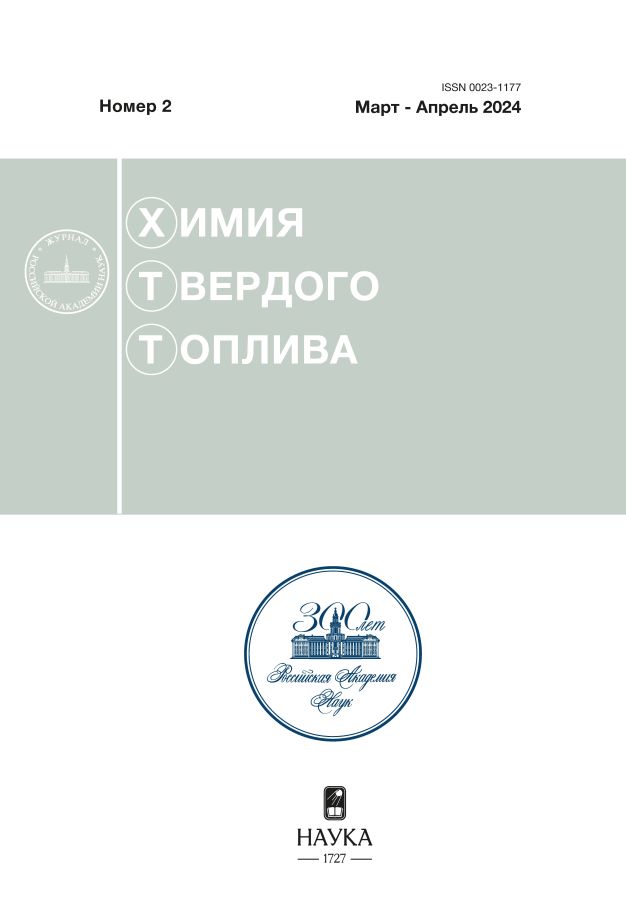Characteristics of High Molecular Components Obtained by Thermal Destruction of Oil Residue Asphaltenes in Supercritical Water
- Authors: Nalgieva K.V.1, Kopytov M.A.1
-
Affiliations:
- Institute of Petroleum Chemistry, Siberian Branch of the Russian Academy of Sciences
- Issue: No 2 (2024)
- Pages: 23-30
- Section: Articles
- URL: https://rjmseer.com/0023-1177/article/view/661572
- DOI: https://doi.org/10.31857/S0023117724020059
- EDN: https://elibrary.ru/OMQAKC
- ID: 661572
Cite item
Abstract
The composition and characteristics of high-molecular components of the thermolysis products of petroleum residue asphaltenes obtained in supercritical water without/with a catalyst based on iron oxides have been studied. The experiments were carried out in an autoclave at a temperature of 450°C for 60 minutes; the catalyst was prepared in situ from iron (III) tris-acetylacetonate. The use of supercritical water and an in situ catalyst makes it possible to increase the yield of saturated and aromatic hydrocarbons by more than 9.5 times compared to the control experiment (thermolysis without water and a catalyst) and reduce the yield of solid products insoluble in chloroform. The properties of high molecular weight components isolated from thermolysis products were characterized using structural group analysis and IR spectroscopy. High molecular weight components obtained by thermolysis in supercritical water in the presence of a catalyst, in comparison with the products obtained in the control experiment, are characterized by a higher H/C ratio and content of oxygen-containing groups, as well as a lower average molecular weight.
Full Text
About the authors
Kh. V. Nalgieva
Institute of Petroleum Chemistry, Siberian Branch of the Russian Academy of Sciences
Author for correspondence.
Email: nalgieva.1997@gmail.com
Russian Federation, Tomsk
M. A. Kopytov
Institute of Petroleum Chemistry, Siberian Branch of the Russian Academy of Sciences
Email: kma@ipc.tsc.ru
Russian Federation, Tomsk
References
- Al-Muntaser A.A., Varfolomeev M.A., Suwaid M.A., Yuan C., Chemodanov A.E., Feoktistov D.A., Rakhmatullin I.Z., Abbas M., Domínguez-Álvarez E., Akhmadiyarov A.A., Klochkov V.V., Amerkhanov M.I. // J. Petroleum Sci. Enng. 2020. V. 184. P. 106592.
- Rana M.S., Sámano V., Ancheyta J., Diaz J.A.I. // Fuel. 2007. V. 86. P. 1216.
- Castañeda L.C., Muñoz J.A.D., Ancheyta J. // Catal. Today. 2014. V. 220–222. P. 248.
- Zhao Y., Wei F. // Fuel Process. Technol. 2008. V. 89. P. 933.
- Li N., Yan B., Zhang L., Quan S.X., Hu C., Xiao X.M. // J. Supercrit. Fluids. 2015. V. 97. P. 116.
- Zhu S., Jin H., Ou Z., Song M., Chen J., Guo L. // J. Mol. Liq. 2022. V. 355. P. 118965.
- Sharan P., Thengane S.K., Yoon T.J., Lewis J.C., Singh R., Currier R.P., Findikoglu A.T. // Desalination. 2022. V. 532. P. 115716.
- Hosseinpour M., Soltani M., J. Nathwani J. // J. Clean. Prod. 2022. V. 334. P. 130268.
- Arcelus-Arrillaga P., Pinilla J.L., Hellgardt K., Millan M. // Energy and Fuels. 2017. V. 31. P. 4571.
- Hosseinpour M., Ahmadi S.J., Fatemi S. // J. Supercrit. Fluids. 2015. V. 100. P. 70.
- Hosseinpour M., Fatemi S., Ahmadi S.J. // Fuel. 2015. V. 159. P. 538.
- Li N., Zhang X., Zhang Q., Chen L., Ma L., Xiao X. // Fuel. 2020. V. 278. P. 118331.
- Hosseinpour M., Ahmadi S.J., Fatemi S. // J. Supercrit. Fluids. 2016. V. 107. P. 278.
- Fedyaeva O.N., Shatrova A. V, Vostrikov A.A. // J. Supercrit. Fluids. 2014. V. 95. P. 437.
- Kozhevnikov I. V., Nuzhdin A.L., Martyanov O.N. // J. Supercrit. Fluids. 2010. V. 55. P. 217.
- Ma Z., Xu D., Guo S., Wang Y., Wang S., Jing Z., Guo Y. // Oxid. Met. 2018. V. 90. P. 599.
- Sato T., Adschiri T., Arai K., Rempel G.L., Ng F.T.T. // Fuel. 2003. V. 82. P. 1231.
- Cheng Z.-M., Ding Y., Zhao L.-Q., Yuan P.-Q., Yuan W.-K. // Energy Fuels. 2009. V. 23. P. 3187.
- Han L., Zhang R., Bi J. // Fuel Processing Technology. 2009. V. 90. P. 292.
- Liu Y., Bai F., Zhu C.-C., Yuan P.-Q., Cheng Z.-M., Yuan W.-K. // Fuel Proc. Technology. 2013. V. 106. P. 281.
- Morimoto M., Sato S., Takanohashi T. // J. Supercrit. Fluids. 2012. V. 68. P. 113.
- Нальгиева Х.В., Копытов М.А. // ХТТ. 2022. № 2. С. 34. https://doi.org/10.31857/S0023117722020074 [Solid Fuel Chemistry, 2022, vol. 56, no. 2, p. 116. https://doi.org/10.3103/S0361521922020070].
- Kamyanov V.F, Filimonova T.A., Gorbunova L.V., Lebedev A.K., Sivirilov P.P. // Nauka, Novosibirsk. 1988. P. 177.
- Kamyanov V.F., Bolshakov G.F. // Petroleum Chem. 1984. V. 24. P. 450.
- Sviridenko N.N., Akimov A.S. // J. Supercrit. Fluids. 2023. V. 192. P. 105784.
- Свириденко Н.Н., Кривцов Е.Б., Головко А.К. // Химия и технология топлив и масел. 2016. №3. C. 285. [Chemistry And Technology Of Fuels And Oils, 2016, vol. 52, no.3, p. 285. https://doi.org/10.1007/s10553-016-0705-2].
- Туманян Б.П., Петрухина Н.Н., Каюкова Г.П., Нургалиев Д.К., Фосс Л.Е., Романов Г.В. // Успехи химии. 2015. № 6. С. 1145. [Russian Chemical Reviews, 2015, vol. 84, no. 11, p. 1145. https://doi.org/10.1070/RCR4500].
- Eletskii P.M., Sosnin G.A., Zaikina O.O., Kukushkin R.G., Yakovlev V. // J. Sib. Fed. Univ. Chem. 2017. V. 10. P. 545.
Supplementary files
















